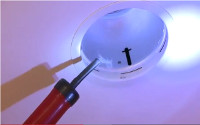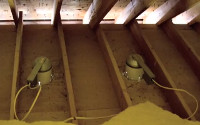Videos

Compared to other common overhead features, can lights are easier to clean and maintain, and the light output helps divide the space, define task areas, and highlight artwork and architectural features. They are also especially valuable in low ceiling areas.
For all the reasons above, new and remodeled homes tend to have this type of feature in at least some of the rooms. Some have them all throughout the house!

There is only one problem concerning can lights: they can be a huge source of energy loss year round! Older fixtures -- especially those installed before 2004 -- were built with little to no regard to energy efficiency, and have plenty of holes and gaps to allow conditioned air from the living space to escape into the attic and eventually out of the house.

Using high-tech home energy diagnostic equipment and procedures, such as a blower door test and thermal imaging camera, Larry demonstrates just how much energy is lost through the gaps left in and around the can lights in this home. With the blower door running, a smoke pencil (smoke generator) is used to illustrate how significant the air loss is within the can lights of this home.

In order to simply and quickly stop air leakage through can light fixtures, Larry installs can light covers that are designed specifically for this purpose with the TightShell. The TightShell, is made of a fire-retardant material known as rockwool, a material that has been tested and designed to withstand up to 2,000 degrees fahrenheit.
Each TightShell can light cover is custom fit to the fixture so that the wires can easily go in and out and around the struts. Once the cover is properly aligned, spray foam insulation was applied to seal air leakages and secure it in place for good.

If you suspect energy waste through light fixtures or any any other area of your home, call or contact your local Dr. Energy Saver today for a free estimate and evaluation.
Areas Served